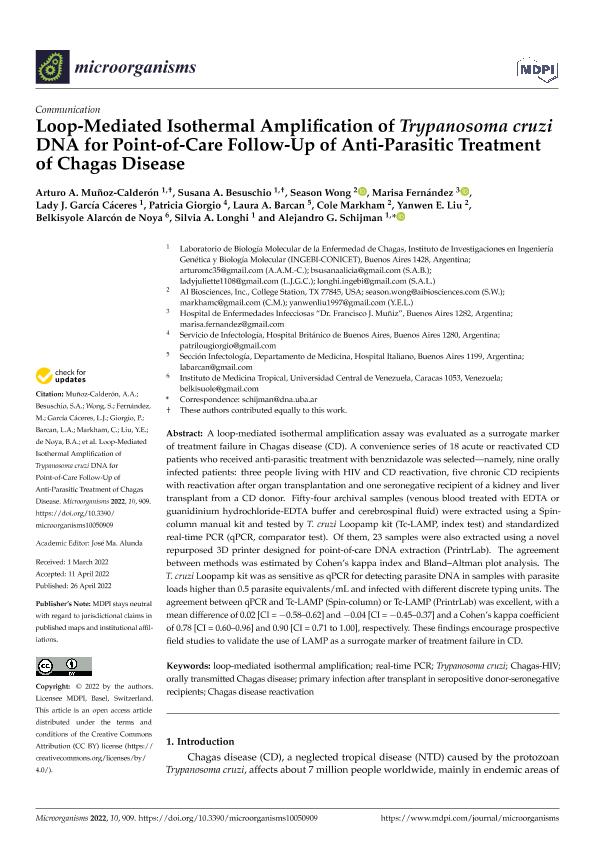Mostrar el registro sencillo del ítem
dc.contributor.author
Muñoz Calderon, Arturo Alejandro

dc.contributor.author
Besuschio, Susana Alicia

dc.contributor.author
Wong, Season
dc.contributor.author
Fernández, Marisa
dc.contributor.author
García Casares, Lady Juliette

dc.contributor.author
Giorgio, Patricia
dc.contributor.author
Barcan, Laura A.
dc.contributor.author
Markham, Cole
dc.contributor.author
Liu, Yanwen E.
dc.contributor.author
Alarcón de Noya, Belkisyolé

dc.contributor.author
Longhi, Silvia Andrea

dc.contributor.author
Schijman, Alejandro Gabriel

dc.date.available
2023-06-26T11:15:14Z
dc.date.issued
2022-04-26
dc.identifier.citation
Muñoz Calderon, Arturo Alejandro; Besuschio, Susana Alicia; Wong, Season; Fernández, Marisa; García Casares, Lady Juliette; et al.; Loop-Mediated Isothermal Amplification of Trypanosoma cruzi DNA for Point-of-Care Follow-Up of Anti-Parasitic Treatment of Chagas Disease; Multidisciplinary Digital Publishing Institute; Microorganisms; 10; 5; 26-4-2022; 1-10
dc.identifier.issn
2076-2607
dc.identifier.uri
http://hdl.handle.net/11336/201412
dc.description.abstract
A loop-mediated isothermal amplification assay was evaluated as a surrogate marker of treatment failure in Chagas disease (CD). A convenience series of 18 acute or reactivated CD patients who received anti-parasitic treatment with benznidazole was selected—namely, nine orally infected patients: three people living with HIV and CD reactivation, five chronic CD recipients with reactivation after organ transplantation and one seronegative recipient of a kidney and liver transplant from a CD donor. Fifty-four archival samples (venous blood treated with EDTA or guanidinium hydrochloride-EDTA buffer and cerebrospinal fluid) were extracted using a Spin-column manual kit and tested by T. cruzi Loopamp kit (Tc-LAMP, index test) and standardized real-time PCR (qPCR, comparator test). Of them, 23 samples were also extracted using a novel repurposed 3D printer designed for point-of-care DNA extraction (PrintrLab). The agreement between methods was estimated by Cohen’s kappa index and Bland–Altman plot analysis. The T. cruzi Loopamp kit was as sensitive as qPCR for detecting parasite DNA in samples with parasite loads higher than 0.5 parasite equivalents/mL and infected with different discrete typing units. The agreement between qPCR and Tc-LAMP (Spin-column) or Tc-LAMP (PrintrLab) was excellent, with a mean difference of 0.02 [CI = −0.58–0.62] and −0.04 [CI = −0.45–0.37] and a Cohen’s kappa coefficient of 0.78 [CI = 0.60–0.96] and 0.90 [CI = 0.71 to 1.00], respectively. These findings encourage prospective field studies to validate the use of LAMP as a surrogate marker of treatment failure in CD.
dc.format
application/pdf
dc.language.iso
eng
dc.publisher
Multidisciplinary Digital Publishing Institute
dc.rights
info:eu-repo/semantics/openAccess
dc.rights.uri
https://creativecommons.org/licenses/by/2.5/ar/
dc.subject
CHAGAS DISEASE REACTIVATION
dc.subject
CHAGAS-HIV
dc.subject
LOOP-MEDIATED ISOTHERMAL AMPLIFICATION
dc.subject
ORALLY TRANSMITTED CHAGAS DISEASE
dc.subject
PRIMARY INFECTION AFTER TRANSPLANT IN SEROPOSITIVE DONOR-SERONEGATIVE RECIPIENTS
dc.subject
REAL-TIME PCR
dc.subject
TRYPANOSOMA CRUZI
dc.subject.classification
Tecnologías que involucran la identificación de ADN, proteínas y enzimas, y cómo influyen en el conjunto de enfermedades y mantenimiento del bienestar

dc.subject.classification
Biotecnología de la Salud

dc.subject.classification
CIENCIAS MÉDICAS Y DE LA SALUD

dc.title
Loop-Mediated Isothermal Amplification of Trypanosoma cruzi DNA for Point-of-Care Follow-Up of Anti-Parasitic Treatment of Chagas Disease
dc.type
info:eu-repo/semantics/article
dc.type
info:ar-repo/semantics/artículo
dc.type
info:eu-repo/semantics/publishedVersion
dc.date.updated
2023-06-22T10:20:21Z
dc.journal.volume
10
dc.journal.number
5
dc.journal.pagination
1-10
dc.journal.pais
Suiza

dc.journal.ciudad
Basilea
dc.description.fil
Fil: Muñoz Calderon, Arturo Alejandro. Consejo Nacional de Investigaciones Científicas y Técnicas. Instituto de Investigaciones en Ingeniería Genética y Biología Molecular "Dr. Héctor N. Torres"; Argentina
dc.description.fil
Fil: Besuschio, Susana Alicia. Consejo Nacional de Investigaciones Científicas y Técnicas. Instituto de Investigaciones en Ingeniería Genética y Biología Molecular "Dr. Héctor N. Torres"; Argentina
dc.description.fil
Fil: Wong, Season. Ai Biosciences, Inc.; Estados Unidos
dc.description.fil
Fil: Fernández, Marisa. Gobierno de la Ciudad de Buenos Aires. Hospital de Infecciosas "Dr. Francisco Javier Muñiz"; Argentina
dc.description.fil
Fil: García Casares, Lady Juliette. Consejo Nacional de Investigaciones Científicas y Técnicas. Instituto de Investigaciones en Ingeniería Genética y Biología Molecular "Dr. Héctor N. Torres"; Argentina
dc.description.fil
Fil: Giorgio, Patricia. Hospital Británico de Buenos Aires; Argentina
dc.description.fil
Fil: Barcan, Laura A.. Hospital Italiano. Departamento de Medicina.; Argentina
dc.description.fil
Fil: Markham, Cole. Ai Biosciences, Inc.; Estados Unidos
dc.description.fil
Fil: Liu, Yanwen E.. Ai Biosciences, Inc.; Estados Unidos
dc.description.fil
Fil: Alarcón de Noya, Belkisyolé. Universidad Central de Venezuela; Venezuela
dc.description.fil
Fil: Longhi, Silvia Andrea. Consejo Nacional de Investigaciones Científicas y Técnicas. Instituto de Investigaciones en Ingeniería Genética y Biología Molecular "Dr. Héctor N. Torres"; Argentina
dc.description.fil
Fil: Schijman, Alejandro Gabriel. Consejo Nacional de Investigaciones Científicas y Técnicas. Instituto de Investigaciones en Ingeniería Genética y Biología Molecular "Dr. Héctor N. Torres"; Argentina
dc.journal.title
Microorganisms
dc.relation.alternativeid
info:eu-repo/semantics/altIdentifier/doi/http://dx.doi.org/10.3390/microorganisms10050909
dc.relation.alternativeid
info:eu-repo/semantics/altIdentifier/url/https://www.mdpi.com/2076-2607/10/5/909
Archivos asociados
